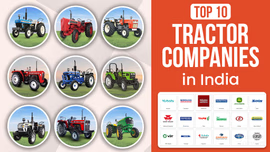History of Tractors in India: Origin, Evolution and Modern Era

Table of Contents
- Tractor Scenario from 1997 to 2015
- Modern Era of Tractors
- Tractor Sales of India in the FY-2023
- Future of the Indian Tractor Industry
The Origin of Tractors
The first appearance of the tractor was seen in the late 19th century. It was a steam-powered iron tractor that was very heavy in weight. In 1892, John Froehlich developed the first farm vehicle powered by a petrol engine. However, these tractors were not successful in the tractor industry. Then, a plough was made, which was becoming successful at that time. Farmall was the first multi-functional tractor capable of ploughing, cultivating, spreading, and threshing. The Garrett 4CD was the most famous steam tractor for road haulage.
The development of the tractor industry has gone through many variations. The gasoline engine tractors were made. In the early 20th century, tractors came with developments like 20 different ignitions, 8 lubrications, 15 transmissions, 11 cooling and 27 different wheel arrangement systems.
In the year 1930, new inventions were introduced in the tractor industry; Harry Ferguson introduced the hydraulically controlled 3D hitching system for implements, called as the Ferguson system. Later, Ferguson and Massey-Harris made Massey-Harris-Ferguson, and then the company name was shortened to Massey Ferguson. In 1991, Fiat owned Ford-New-Holland and renamed it New Holland in 1993.
India’s Scenario in the Development of Tractors
The tractor industry was included as the “core sector” in India’s economic development in 1951. Its growth and development policies were, therefore, reviewed on a plan-to-plan basis. Let’s see India’s growth in the tractor industry in several stages.
Tractor Industry: 1961 -70
Tractor manufacturing in India started in 1961. The mechanization of agriculture was promoted by encouraging the local manufacturing of tractors. After four leaders in the market, Mahindra was the fifth market leader to be licensed with a capacity to manufacture 11,000 tractors. The production rate was slow at that time, so the government decided to invite additional market leaders to the tractor manufacture in 1968. The total number of tractors in 1965 was 5000, and over 20,000 units in 1970. In 1965, the total number was around 52,000 tractors, which increased to 1,46,000 tractors in 1970.
Tractor Industry: 1971-1980
Tractor demand started increasing immensely in 1971 due to the green revolution. 6 units established their manufacturing facilities, of which Escorts established Escort Tractors Limited and collaborated with Ford, U.K. and started manufacturing Ford tractors. Some tractor manufacturers could not survive and shut down their plants. After that, the government of India started promoting indigenous manufacturing to local tractor leaders in the country. The loans were to be given to the farmers to boost the overall sector. The National Bank for Agriculture and Rural Development provided the finance facilities. The market flourished in 1973 when more manufacturers started participating. The tractor industry started expanding rapidly in 1977. A total of 33,000 units in 1975 increased to over 71,000 units in 1980. The total number of tractors that were in use was more than 5,00,000 units.
Tractor Industry: 1981-90
In this period, the tractor industry was at pace. Five more units were set up for the manufacture of tractors. The tractor manufacturers were manufacturing all the tractors indigenously. There was an increase in the production rate of tractors in the post-1980s period. However, some companies could not survive and shut down their plants, except VST tillers and tractors. The Working Group in the Ministry of Industry and, later on, a Group in the Ministry of Agriculture recommended improving the fuel efficiency and power take-off shafts in the tractors. The tractor industry produced 75,000 tractors in 1985 and almost 1,40,000 tractors in 1990. The number of tractors in use was 1.2 million units in 1990. India became an exporter after this period.
Tractor industry: 1991-98
During the nineties, there was a huge change in the tractor industry. The tractor manufacturers were able to receive industrial licenses and government approval in 1992. The international companies also participated in the production of tractors in India. However, imports of fully built tractors were restricted at that time. Farmers were taking advantage of loans like in previous years. Escorts started to produce Farmtrac tractors after its collaboration ended with Ford. Bajaj Tempo started manufacturing tractors in 1997 and International Tractors (Sonalika) started it in 1998. A total of 2,55,000 units were produced during 1997. The total number of tractors in use was over two million units.
Tractor Scenario from 1997 to 2015
The period from 1997 to 2015 was remarkable in the history of tractors. Five more tractor manufacturers joined in the production of tractors in India. Bajaj Tempo set up its plant in Pune in 1998. Later, they changed their name to Forces Motors. Larsen and Toubro started manufacturing 35-65 HP tractors with John Deere in Pune, Maharashtra. Also, New Holland started manufacturing 70 HP tractors in Greater Noida, U.P. and had an annual capacity of manufacturing 35,000 units. Greeves Ltd. also joined hands with Deutz-Fahr of Italy. In 1999, Bharat Trem I emission norms were started in October. Later, in 2003-2011, Bharat Trem II and Bharat Trem III and Trem IIIA emission norms were implemented. In 2013, India contributed 29% of tractors to the world's tractor market, and its production was 6,19,000. In 2014, Zetor came back to India and started manufacturing 40-75 HP tractors with local companies under the Zetor brand name.
Modern Era of Tractors
As we have seen the time period of the tractor industry so far, it is time to discuss some facts about the modern era of tractors. Today, India is one of the biggest tractor industry markets in the world and accounts for 1/3 of total global tractor production. It has the most popular tractor manufacturers, such as Mahindra, Swaraj, Sonalika, John Deere, Escorts, etc.
For decades, Mahindra has been the largest tractor manufacturer and has the highest production in the country. They have manufacturing facilities across 8 countries around the globe. Swaraj is another market leader. With a cumulative sale of 5,00,000 Swaraj tractors; it achieved its first milestone in 2002. Then Mahindra acquired the brand in 2007. The total sales of tractors crossed 15,00,000 in 2018. The brand has continuously launched many tractor models, and now it completes 50 years of transforming India with its best manufacturing. TAFE (Tractors and Farm Equipment) Limited is one of the major brands in the tractor industry which was established in 1960 at Chennia, India. It is the second largest tractor manufacturers by volumes in India. The company stands among top brands having 1600+ dealers with one of its iconic tractor brands – Massey Ferguson. It also won a prestigious award of ‘Best Tractor Between 41-45 hp' for the Massey Ferguson 244 DYNATRACK 4WD, and ‘Classic Tractor of the Year’ for the Massey Ferguson 1035 DI. Tafe acquired Eicher tractors in 2005. In July 2023, TAFE won the ‘Launch of the Year’ award for Eicher PRIMA G3 range of tractors. Another popular brand is Sonalika, which is the 3rd largest tractor manufacturer in India and among the top 5 tractor manufacturers around the world. It has a market share of 15.3% in FY'24 and the biggest ever, 1,51,160 overall annual tractor sales in FY’23. The other brands that are helping to transform India’s tractor industry are Escorts, John Deere, Tafe, etc.
Now, the tractor industry has been transforming in many ways. Sonalika created a revolutionary history by launching India’s first electric tractor to boost the economy and make it a more technologically advanced country. Mahindra has come up with a CNG tractor in Central India's largest Agri Summit at Nagpur in the presence of Shri. Nitin Gadkari, the Honourable Minister of Road, Transport, and Highway, Government of India. A CNG tractor reduces emissions by nearly 70% compared to diesel tractors. Then, Solis tractors company was launched, a sister company of Sonalika. In 2020, VST Tillers Tractors signed a Memorandum of Understanding (MoU) with Zetor Tractors for the joint development of the products, which are sold through VST channel partners in India and Zetor channel partners in the international market. In 2022, Bharat Trem IV, January 2023 emission norms were transitioned for more than 50 HP tractors. New implements were introduced to boost farm productivity, such as Super seeder, Happy seeder, and other crop residue management implements such as baler, mulcher, etc.
Tractor Sales of India in the FY-2023
Over the years, tractor industry has been on a growth trajectory. This is a clear indication that farms across India are mechanizing. Mahindra & Mahindra present two brands in the market, Mahindra tractors and Swaraj tractors which are today the top 2 players by market share. Here, we have listed complete brand wise sales & market share for your knowledge.
|
Tractors |
Sales FY-23 |
Market Share (%) FY23 |
|
Mahindra |
1,76,736 |
21.36% |
|
Swaraj |
1,28,698 |
15.55% |
|
Sonalika |
97,743 |
11.81% |
|
Massey Ferguson |
92,546 |
11.19% |
|
Escorts Limited (Agri Machinery Group) |
79,531 |
9.61% |
|
John Deere India Pvt Ltd |
60,450 |
7.31% |
|
Eicher Tractors |
52,870 |
6.39% |
|
New Holland |
30,047 |
3.63% |
|
Kubota |
20,753 |
2.51% |
|
Others |
88,029 |
10.65% |
|
Total |
8,27,403 |
100.00% |
Future of the Indian Tractor Industry
The Indian tractor industry is now well-established and flourishing. We can expect more innovations and advancements in the coming years. Tractors with AC cabins and emission norms have already been introduced; now, we can expect more autonomous tractors that can drive and sync with autonomous implements themselves. Tractors with motion detection sensors, climate-controlled cabins, Internet connectivity and many more features will increase farm productivity and save farmer’s time. Also, the government should come up with more credit schemes, subsidies, and initiatives to help farmers financially.
Moreover, if you want to know more about tractors and implements, check out Tractorkarvan. Here, you will get to know about tractors, implements and tractor-related blogs for a better understanding. Tractorkarvan will always help you with such blogs in the future.


Related Blogs












